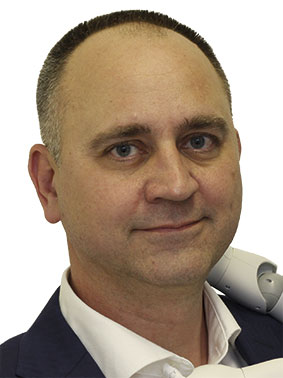
We are talking with Eric Wesselman, a partner with KPMG Management Consulting and responsible for Social Robotics with this multinational advisory firm. In this interview Eric provides his view on the current state of social robotics and the developments and challenges he sees in this domain.
Robots that can socially interact with us in non-structured environments like our living rooms or the public street seem less far away in the future than we may care to believe. Social developments such as aging and the rapidly increasing costs of health care on the one hand, and technological developments like the Internet of Things in combination with a whole gamut of small powerful computers, cheap sensors and new batteries on the other, have catalyzed the development and applicability of Social Robotics. Currently Social Robotics enjoys a lot of attention from executives from amongst other healthcare and education-related institutions and hotel chains, for example, but also from sociologists and economists. A great deal of experimenting is being conducted with new applications of this type of robots and associated business models.
Why are you, as a KPMG partner, actively involved in the field of Social Robotics?
Ever since I was a young boy I have always been excited about technology and space exploration. And robots. I used to watch programs like Buck Rogers, Battlestar Galactica and Star Trek. In all these television series robots played a part. It wasn’t until much later that I bought my first robot, Sony’s AIBO. This digital pet is a real social robot, designed to interact with people. Sony stopped its production in 2005, and some people, in Japan in particular, are struggling to keep their digital pets “alive”. The impact was immediately clear to me. Those people had embraced their AIBOs as their own family members. Much later, in 2014, I bought a NAO robot, which is still being produced by Aldebaran (www.aldebaran-robotics.com). Originally intended as a robotics development platform for universities, this 58 cm tall humanoid has the real potential of being further developed as a social robot. Much attention has been given to the design and its outward appearance. Elderly people and children alike associate easily with the NAO robot. As it is built on an open Linux-based platform and equipped with a powerful Software Development Kit, even less IT-savvy people can program it. When I bought the robot I had our young talents in mind. I wanted to introduce them to this new disruptive technology so that they could work with it, talk about it with our clients and be inspired by it.
Inspiration, that’s all very fine. But what impact do you think KPMG can make in the field of Social Robotics? Surely you’re not a robotics company.
Good question. In September 2014 I attended a NAO Unconference at the Queen Mary University in London, a so called non-structured conference. Here you write your name, the company you work for and the topic on a Post-it note and stick it on a whiteboard. When all present have done so, it is decided by vote who is allotted speaking time by the panel chairman to explain his sticky note. The Unconference was predominantly attended by boffins, especially programmers. They all belonged to the open development community facilitated by Aldebaran to build Apps for their NAO platform. Apps are Dialogue sessions between a human and the AO robot, for example, grasping objects, looking up information on the internet on demand and autonomous navigation. The idea behind this is that if Aldebaran or programmers combine these Apps, complete solutions can be created. If this is successful, it is expected the robot will sell itself as people will want the product with all its functional features.
On the sticky note I had put on the whiteboard was the question “Why does KPMG have a NAO robot?” The attendees were eager to hear the answer, so I was asked to give a presentation. There I stood, in a room full of engineers, and I asked them who had made money on doing developing work on the NAO robot. A deafening silence. I explained that they wouldn’t have a great chance of making money writing programs for the NAO robot without considering the elements of the business model canvas first. I talked about the concept of ecosystems and business model canvasses. They were surprised, not having expected an economic talk at such an event. Afterwards, during the break, they all came to talk to me, one after the other. There I was, a business consultant amidst a group of brilliant programmers, explaining how they could make money on programming the robot. In the course of the day I also came up with the idea that there might well be a market for supporting the development of business models around this new technology. On the demand side we currently see that many questions such as “Should we deploy a robot – and if so, what kind – to solve issues in the business processes?” or “How do we get the most value add out of the solution?” remain unanswered. And on the supply side questions like “What does the ideal ecosystem look like?”, “Where is our value add and how do we make money with it?”, and “Where are potential risks in our revenue model?”
Do you get questions from clients about Social Robotics?
Yes, a number of companies have already expressed their desire to collaborate with us or to engage us in projects involving Social Robotics. Most of them are companies that want to deploy social robots in their businesses. What comes to mind are health care and educational organizations, and hotels. In addition, I and a number of my colleagues speak at Social Robotics-oriented events. Here we do not just talk about the technology and the business models, but also about ethics and legislation. You can imagine how important ethics are in the context of healthcare, particularly when you talk about care for elderly people. The lack of personal contact is one of the key themes in this context. When we talk about children another theme is important, that of social development. You wouldn’t want your child to learn social skills in the broadest sense from a robot. Next to ethics we also look at legislation. In this context an important aspect is privacy. A social robot typically has a fast array of sensors that can capture and store videos, pictures and sound as well as temperature, humidity and many other things such as patterns of activity. Questions that come up are: who owns the data and who can access them? Current legislation doesn’t always provide for answers in the context of robotics. The technology is so new that legislators still have to formulate law on the subject. Last but not least there is the topic of safety and (cyber)security. Although most robots are designed to be safe, I am aware that the security of some of the social robots is unsatisfactory. They can be hacked relatively easily and there exists little cyber monitoring to identify and mitigate threats. Also, insurance for damages, either material or personal, caused by a robot is yet to be developed. Currently few case histories are known on which insurance companies can base a sensible insurance policy.
How do you see the future of Social robots?
Already today I see that social robots have made their entry in care, education and hospitality. In this setting they have been designed to execute a very specific task. At present, there is hardly any real intelligence in what they do. So-called avatars of energy companies answer specific questions from customers, humanoids train autistic children on making eye contact, others are being used in education to spice up the format and content of a daily teaching program. But remember, these are all used in a fairly structured environment. I expect that in the next decade we will see a rapid development of Social Robotics applications in less structured environments. This will be made possible once the brain power of such social robots is built on Artificial Intelligence such as IBM’s Watson, which would then be accessed through the Cloud. This will enable the robot to respond and adjust to a constantly changing unstructured environment, such as a hospital, your home or your office, and still have oversight and control from and by people. In 30 years from now social robots may have evolved to such an extent that they are capable of combining multiple tasks and working autonomously in an unstructured environment. So-called brain EMS (or emulations) will provide the brain power for the Social Robotics work force to do so. They will then act based on their own collective judgement, but according to a clear set of rules. Whether that is ethically desirable or not remains to be seen. With the rise of social robots we have embarked on a journey to interesting times and I am looking forward to it!
Eric Wesselman is a partner with KPMG and a sector leader Oil & Gas. Apart from his industry focus, Eric has a passion for new applications of technology. For two years he has been active in the field of the international social robotics community, where he focuses on business models. He is one of the founders of the Social Robotics pop-up Lab, an Institute focusing on the development and sharing of knowledge on social robotics (www.popup-lab.com).



